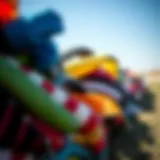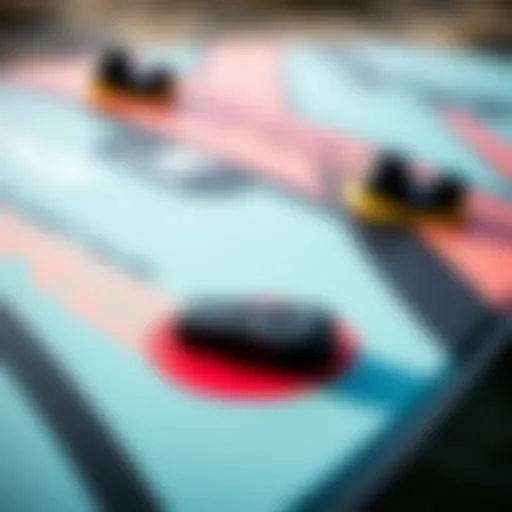Kitesurfing in Punta Cana: A Complete Guide
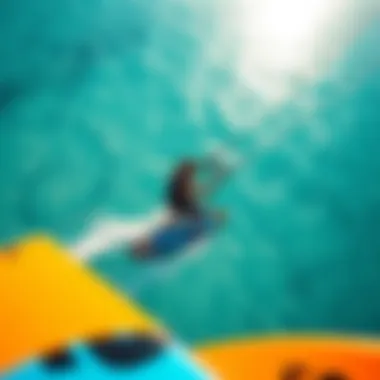
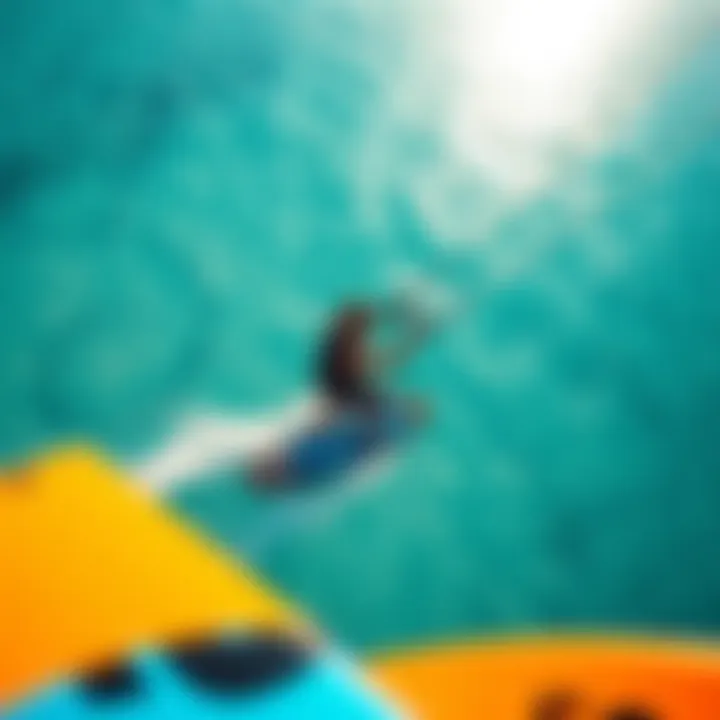
Intro
Kitesurfing in Punta Cana is not just a sport; it’s an exhilarating adventure where the ocean meets the sky. This Caribbean paradise combines the mesmerizing beauty of turquoise waters with predictable winds, making it an ideal playground for both newbies and seasoned kiteboarders. Whether it’s the gentle breezes or the more robust gusts, Punta Cana offers a variety of conditions that can accommodate many skill levels.
As enthusiasts flock to its shores, it’s crucial to get a grasp of what this locale has to offer. From checking local wind patterns to understanding the gear you’ll need, the journey into kitesurfing here has many facets. The beauty of Punta Cana is captivating, but understanding the intricacies of kitesurfing can elevate the experience from ordinary to extraordinary. Knowing what to expect from the local community, the safety practices, gear essentials, and spots for those pristine rides can be the difference between a memorable adventure and one filled with mishaps.
This article aims to provide a solid foundation for kitesurfing in Punta Cana, unveiling the essentials and best practices for maximizing your time on the water. As you read through, you’ll find information that can assist in honing your skills, picking the right gear, and connecting with fellow kiteboarders. All of this can enhance your experience as you navigate the stunning waters of the Dominican Republic, creating memories that will last a lifetime.
Gear Insights
Latest Gear Reviews
Having the right gear is monumental in kitesurfing. The ever-evolving nature of kitesurfing equipment means that what was once top-of-the-line may not be suitable now. The latest kites on the market, such as the Duotone Rebel 2023 and the Cabrinha Switchblade, promise high performance, durability, and ease of control. These kites are engineered to provide stability in a variety of wind conditions, with a responsive feel that can cater to both beginner learning curves and advanced maneuvers.
In addition, boards like the Naish Skater and the Slingshot Mask provide excellent pop and smooth landings, catering to those who are keen on tricks. Each brand comes with its own flavor of responsiveness and comfort, allowing riders to choose what aligns best with their riding style. For harnesses, the Mystic Majestic is a crowd-pleaser for its comfort and support, especially during those long sessions on the water.
Essential Gear for Beginners
For those just starting out, there’s no need to break the bank. A good quality kite-sized between 9 to 12 meters is generally ideal for the varied winds of Punta Cana. Look into options like the North Impact or the Cabrinha Spectrum—they provide stability and forgiveness, great for those stepping onto the board for the first time.
When it comes to boards, a twin-tip board is recommended as it allows for easier riding and maneuverability. Also, don’t overlook safety equipment. A helmet and impact vest are essential for your protection, especially when venturing into shallow waters or when the wind picks up unexpectedly.
"Having the right gear not only enhances performance but also improves safety; never skimp on equipment that protects you."
Ensuring you have the basics—good harness and safety leash, for instance—creates a solid foundation for learning.
Techniques and Tips
Advanced Tricks and Techniques
Once you feel comfortable riding, it’s time to establish more advanced techniques. Learning to jump involves mastering the edge of your board. By carving into the wind and loading your line, you can create lift and height. Tricks like the backroll or front roll require not only skill but also confidence in your gear's performance. Develop your tricks in a controlled area before hitting the open sea to avoid mishaps.
Safety Practices for Kiteboarders
While kitesurfing is fun, it’s crucial to prioritize safety. Always check the weather conditions before heading out. Understanding the wind direction and potential storms can be lifesaving. Equally important is to make friends with fellow kiteboarders who can offer tips or even rescue if the situation arises. Never kite alone, and familiarize yourself with the local regulations surrounding kiteboarding in Punta Cana.
Also, familiarize yourself with the beach layout—identifying hazards and launching zones can significantly reduce the risk of accidents. Participate in the local kiteboarding community; experience and advice from others can provide insights that enhance your kitesurfing experience.
For further resources, consider checking out Wikipedia, Britannica, and the Kiteboarding subreddit for tips on gear and tricks.
As you explore the sea in Punta Cana, keep safety in mind and enjoy every moment whipping through the waves.
Preface to Kitesurfing
Kitesurfing has emerged as a thrilling water sport that combines elements of surfing, windsurfing, and paragliding. It invites enthusiasts to harness the power of the wind while riding the waves. In this section, we’ll explore the essentials that define kitesurfing, its significance within the context of this article, and why it has captivated adventurers worldwide.
Definition and Overview
At its core, kitesurfing involves riding on a board while being pulled by a kite that is flown in the air. This kite captures the wind, providing the necessary propulsion to glide across the water. It's not just about the physical activity; it’s about the exhilaration that comes from mastering the elements. People often describe the feeling of kitesurfing as akin to flying, where the rider feels a blend of freedom and thrill.
One of the pivotal benefits of kitesurfing is how accessible it has become. With advances in equipment technology and an increase in kitesurfing schools, beginners can quickly learn the ropes. There’s a welcoming community around the sport, with opportunities to connect with others through classes and local events. Also, thanks to places like Punta Cana, where conditions are ideal, the sport finds a perfect playground for riders of all stripes.
Historical Context
Kitesurfing, or kiteboarding as it’s sometimes called, isn't as young a sport as many might think. Its roots can be traced back to the late 1800s when kites were used as a means to enhance the performance of smaller boats. Fast forward to the 1970s, and innovators like Peter Lynn began experimenting with inflatable kites that eventually paved the way for the kitesurfing we know today.
In the late 1990s, the sport began to gain traction, with boards designed specifically for kitesurfing entering the market. By the early 2000s, it was officially recognized as a sport, with international competitions taking shape. Today, it has become a global phenomenon, celebrated for its adrenaline-pumping thrills.
Kitesurfing’s evolution reflects advancements in safety measures and techniques, along with an ever-growing community of enthusiasts eager to push boundaries. With the rise of social media, communities are flourishing online, making it easier than ever to connect, share tips, and promote kitesurfing events.
"Kitesurfing is not just a way to ride the waves; it’s an expression of freedom, allowing individuals to connect to nature in a unique way."
Understanding the history and definition of kitesurfing helps us appreciate why destinations like Punta Cana have become popular havens for the sport. As we delve deeper into this article, we will explore the local conditions, essential gear, and all that Punta Cana has to offer to both novice and seasoned kiteboarders.
Punta Cana: A Kitesurfing Haven
Punta Cana stands tall, not just as a tourist magnet but as a premier destination for kitesurfing enthusiasts around the globe. The blend of ideal geographical features, coupled with a friendly climate, makes it a watery playground. For those who crave the exhilaration of riding the waves, Punta Cana has carved its niche out of sun-drenched beaches and consistent breezes.
Geographical Features
The geography of Punta Cana is a kitesurfer’s dream come true. The coastline stretches for miles, embellished with pristine beaches, turquoise waters, and coral reefs just waiting to be explored. Areas like Bavaro Beach and Macao Beach provide the perfect launch points.
The shallow waters near the shore offer perfect conditions for beginners to practice, while the deeper waters challenge the more seasoned rider. Some noteworthy spots include:
- Bavaro Beach: Well-known for its smooth sandy bottom and consistent winds.
- Macao Beach: A bit more rugged, it's favored by advanced riders due to its waves and thrilling conditions.
- Uvero Alto: Less crowded, making it ideal for those who want a peaceful experience.
These geographical elements, combined with easy access to amenities, draw kiteboarders from various backgrounds. It’s the sort of place where you can feel the warmth of the sun one moment and chase a wave the next.
Climate and Wind Conditions
When it comes to kitesurfing, weather dictates the experience, and Punta Cana serves it up just right. The region enjoys a tropical climate, offering warm temperatures year-round, typically ranging from 75°F to 85°F. However, it's the wind conditions that truly charm kitesurfers. Prevailing trade winds dance across the water from November to June, usually ranging between 12 to 25 knots.
These are the ideal conditions for kitesurfing, allowing for thrilling rides, effortless lifts, and endless jumps. However, it's essential to keep an eye on the weather reports, as conditions can shift, especially during the hurricane season. In general, smooth sailing or riding often relies on understanding and timing the wind patterns, which become second nature for local and visiting riders alike. A good resource for real-time wind conditions is Windy.
Best Time to Visit
To make the most of your kitesurfing adventure, timing is everything. The prime season to visit Punta Cana, particularly for kitesurfers, is from November through June. This period coincides with the northeast trade winds, making kitesurfing conditions predictable, reliable, and downright enjoyable.
- November to February: These months see consistent wind speeds and milder temperatures. Perfect for both beginners and skilled riders, this is the high season, so anticipate some crowds.
- March to June: Winds peak during late spring, bringing excitement and the opportunity to push beyond one's limits. Additionally, summer is approaching, which allows for some delightful sunset kitesurfing sessions.
Travelers should book their trips early to secure the best spots. If traveling during peak times, expect to mingle with other water sports enthusiasts, a vibrant community eager to share tips and tricks.
"Punta Cana isn’t just about sunbathing; it’s where the sea meets the sky in harmony, calling out to adventure seekers.”
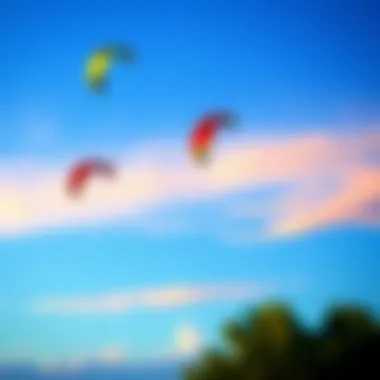
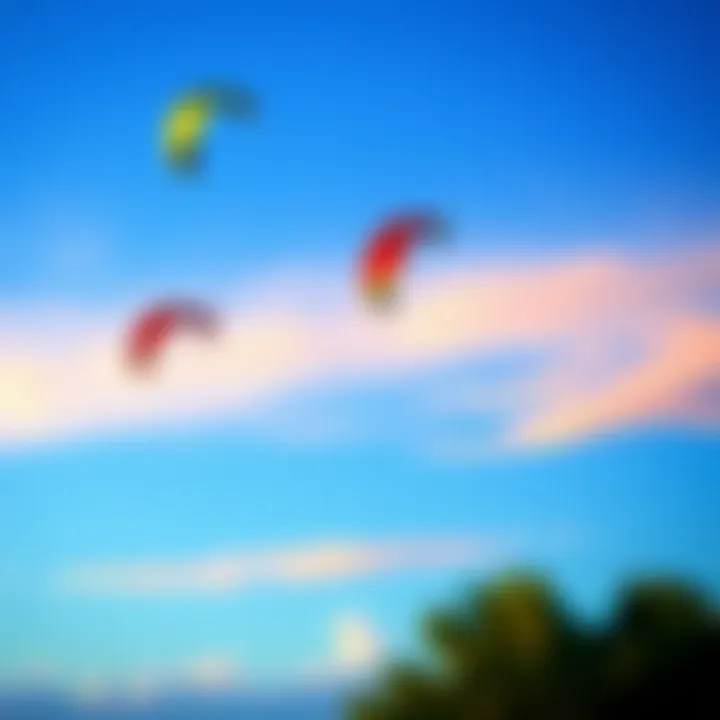
Each of these elements contributes to the allure of Punta Cana as a kitesurfing haven, creating unforgettable experiences on the water. Engaging with these surroundings not only cultivates skill but weaves stories that last well beyond the waves.
Essential Gear for Kitesurfing
When it comes to kitesurfing, having the right gear is more than just a matter of preference; it’s a necessity that can make or break your experience on the water. Whether you're a newcomer to the sport or an experienced kiteboarder, choosing the right equipment plays a pivotal role in efficiency, safety, and ultimately, enjoyment. The right gear not only ensures you are adequately supported while you're mastering your skills but also contributes to a smoother ride across the waves.
Kites: Types and Specifications
The kite itself is your lifeline when kitesurfing. A well-chosen kite helps harness the wind effectively, allowing you to soar and maneuver with ease. There are mainly two types of kites - inflatable kites and foil kites.
- Inflatable Kites: These are the most popular choice among beginners and intermediates due to their ease of use and stability. They come in various sizes and can be inflated with air, which gives them a characteristic shape. Ideal for water launches, inflatable kites can also lift off well in light wind conditions.
- Foil Kites: More common among seasoned riders, these kites are designed without bladders and can be lighter, easier to pack, and more efficient in storing power. However, they require a bit more skill to fly and maintain.
Additionally, pay attention to the specifications like the aspect ratio and material. The aspect ratio refers to the shape of the kite, influencing how it cuts through the wind. Higher aspect ratios are generally more efficient but require good technical skills. Choosing a durable material is vital too; ripstop nylon is a common choice, ensuring longevity and resilience against the elements.
Boards: Selecting the Right One
Choosing the right board can significantly influence your comfort and performance on the water. Boards come in three main styles: twin-tip, directional, and foil boards.
- Twin-tip Boards: These are highly versatile and the go-to option for most kitesurfers, especially beginners. Here, you can ride either direction, which makes learning a lot easier.
- Directional Boards: Think of surfing; these boards are shaped more like traditional surfboards. They're ideal for wave riding and offer a different kind of thrill but can be trickier to handle.
- Foil Boards: For the avant-garde kitesurfer, foil boards elevate you off the water's surface, enabling you to glide smoothly and swiftly. Mastering these boards requires practice but proves immensely rewarding.
When selecting a board, consider the size as well. A larger board is easier to balance on and perfect for light winds, while a smaller board offers better performance in stronger winds. Foot strap placement can also affect your ride, so always go for options that fit your style and preference.
Harnesses and Safety Equipment
Safety should never take a backseat, and a well-fitted harness is critical for that. Your harness connects you to the kite and allows you to transfer power efficiently without straining your arms.
There are two types of harnesses: waist harnesses and seat harnesses.
- Waist Harnesses: These sit above your waist and provide greater freedom of movement, making them popular among freestyle riders.
- Seat Harnesses: Sitting lower on the body, seat harnesses are usually recommended for beginners or those needing additional back support, as they distribute the load more evenly.
Additionally, don’t disregard safety equipment. A impact vest or buoyancy aid adds a layer of protection in case of falls, while a helmet protects your head from unexpected collisions. Invest in a leash; it ensures that if you lose grip on your kite, it won’t drift away, which could lead to dangerous situations.
Remember, investing in high-quality gear can sometimes mean the difference between an exhilarating experience and an unpleasant one.
In summary, adequate gear selection can dramatically affect your kitesurfing journey in Punta Cana. You'll not only enjoy the thrill of riding but also prioritize safety, making each session on the water memorable.
For further reading and detailed insights on kites and boards, check out Wikipedia's Kitesurfing page.
Engaging in this vibrant sport is as much about choosing the right gear as it is about the thrill of the ride.
Techniques and Skills Development
Understanding the techniques and skills involved in kitesurfing is crucial for any enthusiast who wants to maximize their enjoyment and safety on the water. Gaining proficiency isn’t just about having the right equipment; it’s about mastering the art through practice and continuous learning. Each level of skill comes with its set of challenges and rewards, and knowing where to focus your efforts can make all the difference.
Basic Techniques for Beginners
For those just starting out, grasping basic techniques lays the foundation for everything that follows. First off, mastering kite control is essential. This includes how to launch, land, and maneuver the kite safely in various conditions. Let’s break this down into manageable steps:
- Kite Setup and Safety Checks: Before hitting the water, ensure that your kite is properly inflated and all safety systems are functional. This includes checking lines and bridles for any tangles or damage.
- Launching and Landing the Kite: Understanding how to launch your kite safely — generally with the help of a buddy — is critical. Conversely, landing can be taught by practicing controlled descents, avoiding jerks that could cause accidents.
- Riding on the Board: The first time you get on the board can feel like trying to balance on a tightrope. Start in shallow water. Position your feet in the foot straps, and while keeping your weight centered, gently pull on the kite towards the side to steer while managing your speed.
These steps may feel a bit overwhelming at first, but with practice and patience, you’ll find yourself getting the hang of it.
Intermediate Skills and Tricks
Once you’ve conquered the basics, you’ll likely feel the itch to improve. Intermediate skills often focus on boosting your confidence and introducing fun tricks. Here are some key elements:
- Carving Turns: This technique involves shifting your weight and edging your board against the pull of the kite. It not only improves your control but also prepares you for more advanced maneuvers.
- Jumping: Here’s where the fun really kicks in. Start by practicing small jumps; it’s all about timing the pull of the kite with your board's edge. Bend your knees when taking off, and when you're airborne, keep the kite steady.
- Transitioning: Learning how to switch directions smoothly while keeping the flow is important. This involves a smooth turn and redirecting the kite in time with your movement.
This stage is all about refining your skills, so don’t be shy about practicing these techniques over and over.
Advanced Techniques for Experts
For seasoned kitesurfers, the focus shifts towards enhancing performance and achieving more complex tricks. Advanced skills often require a combination of control, finesse, and some daring. Consider these:
- Powered Jumps and Tricks: Expert jumpers can catch big air by precisely timing their take-off with kite dynamics. Executing tricks like rotations or flips adds flair, showcasing high-level skills.
- Riding Unhooked: This advanced technique involves detaching from the harness, requiring strong core and kite control. It’s essential to practice this in safer conditions before attempting it in choppy waters.
- Freestyle Moves: From the simplest grab to intricate rotations, freestyle moves can be an exhilarating way to express your style on the water. They require a lot of practice but can be incredibly rewarding.
"With great kitesurfing comes great responsibility; learn the techniques well, and the waters will open up in ways you never imagined."
Each skill level builds upon the last, so never rush past one phase without fully mastering it. Always seek to improve, whether through personal practice or by combining it with lessons through schools in Punta Cana like Dominican Kitesurfing School or Kite Club Punta Cana.
Safety Considerations in Kitesurfing
Kitesurfing can be an exhilarating experience, but with that thrill comes a responsibility to ensure safety on the water. Understanding the risks and implementing effective safety practices not only protects oneself but also creates a safer environment for everyone involved. Engaging in kitesurfing means being aware of varying conditions, equipment selections, and potential emergencies that may arise. Safety considerations play a pivotal role in enhancing the overall experience, ensuring that kitesurfers can focus more on enjoying the waves rather than worrying about what can go wrong.
Understanding Risks and Hazards
The ocean isn’t just a playground; it's dynamic and can be unpredictable. Among the various risks associated with kitesurfing are:
- Weather Conditions: Strong winds, sudden squalls, and changing tides can significantly impact the safety of kitesurfers. Always check local weather forecasts before hitting the water.
- Equipment Failure: Gear must be regularly inspected for wear and tear. Components can fail unexpectedly, especially if they have been improperly stored or maintained.
- Collision Hazards: Crowded waters can lead to unintentional collisions, whether with other kite surfers, boats, or even submerged objects. Awareness of one’s surroundings is crucial.
- Water Conditions: The quality of the water can vary. Look out for rip currents, shallow reefs, and sharp objects submerged that can cause injury.
By understanding these risks, kitesurfers can take measures to avoid dangerous situations. It's advisable to engage in thorough pre-launch checks of all equipment and to practice caution in crowded areas where mishaps are more likely to occur.
Emergency Procedures and Rescue Tips
Preparation for emergencies is equally vital. Having a well-thought-out plan can mean the difference between a close call and a serious situation. Here are some essential procedures and tips:
- Know Your Signals: Establish clear hand signals with fellow learners or friends. In case of an emergency, being able to communicate quickly and effectively can save time.
- Self-Rescue Techniques: Familiarize yourself with self-rescue techniques such as the "water start" or detach-tether recovery. Understanding how to handle your equipment in distress plays a significant role in safety.
- Calling for Help: If needed, don't hesitate to wave and shout for assistance. Keep a waterproof whistle on your harness for easier signaling.
- Emergency Contacts: Always keep a list of emergency numbers handy, including local rescue services or kitesurfing schools.
- Buddy System: Whenever possible, kitesurf with others. Having someone nearby can be key in case of emergencies.
"Being prepared and knowing how to act in emergencies can transform a frightening scenario into a manageable situation."
Emphasizing safety in kitesurfing not only benefits individual kitesurfers but fosters a culture where everyone looks out for one another. The combination of understanding the risks and being prepared can ensure a safer and more enjoyable time on the water.
Kitesurfing Schools and Experts in Punta Cana
Kitesurfing schools and expert instructors are the backbone of the kitesurfing experience in Punta Cana. They provide invaluable resources for both beginners eager to learn the ropes and seasoned riders who want to polish their skills. In a sport that can be as daunting as it is thrilling, having professional guidance ensures not only competence but also safety in the water. Let’s dive into the landscape of educational opportunities and expertise available in this vibrant locale.
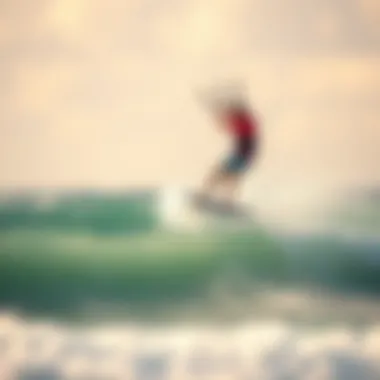
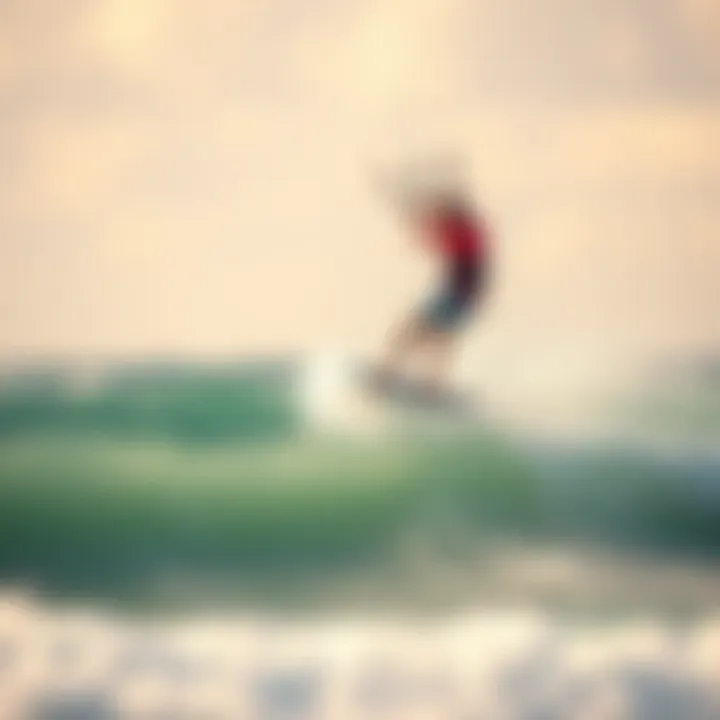
List of Reputable Schools
In Punta Cana, several kitesurfing schools stand out for their quality of instruction, safety standards, and overall customer satisfaction. Here’s a look at some noteworthy ones:
- Kiteology: This school has carved out a name for itself, offering enthusiasts a step-by-step learning framework. Their instructors are well-trained and bilingual, catering to a diverse clientele.
- Punta Cana Kiteboarding: Known for its welcoming atmosphere, this school provides tailored lessons that fit any skill level. They also promote group lessons, so it’s easy to find fellow kitesurfers.
- Kite Club Punta Cana: With a clear focus on safety, their sessions emphasize proper technique alongside fun and leisure. The school maintains a positive ratio of instructors to students, ensuring personalized instruction.
- Blue Water Kiteboarding: They offer unique packages that integrate local culture with kitesurfing, providing an immersive experience that goes beyond just the sport.
Each of these schools not only trains students in kitesurfing but also fosters a community where participants can connect and share their passion for the ocean.
Instructor Qualifications and Experience
Guiding novice kitesurfers through the initial learning curve requires not just certification but also a deep understanding of local conditions. Instructors in Punta Cana typically possess several key qualifications:
- Certified Trainers: Most instructors hold certifications from respected bodies such as the International Kiteboarding Organization (IKO). These certifications reflect their commitment to safety and effective teaching.
- Experience with Local Conditions: Instructors who are familiar with Punta Cana's unique wind patterns and water conditions can give tailored advice to students, maximizing their learning experience.
- Multi-lingual Skills: With the area attracting tourists from all over the world, being fluent in multiple languages is a common trait among instructors. This makes communication smooth and enhances learning.
- Passion for the Sport: An enthusiastic instructor not only makes lessons enjoyable but also instills a genuine love for kitesurfing in their students.
Choosing schools staffed with well-qualified and experienced instructors cannot be overstated; it greatly enhances the likelihood of developing skills in a safe, supportive environment.
"Learning kitesurfing under an experienced instructor can make the difference between a thrilling adventure and a daunting experience, especially in a unique area like Punta Cana."
For those looking to pursue kitesurfing in Punta Cana, seeking out recognized schools with a track record of success not only equips students with skills but also cultivates lasting friendships and a deeper appreciation for this exhilarating sport.
For more information, you can visit Kiteboarding Events or forums like Reddit Kiteboarding.
With expert guidance, the dream of soaring above the aqua-blue waves can become a reality.
Local Regulations and Etiquette
Understanding local regulations and etiquette is crucial when kitesurfing in Punta Cana. These guidelines not only ensure safety but also promote a sense of respect among riders and the surrounding community. Embracing good practices allows kitesurfers to enjoy the sport while minimizing conflicts and preserving the environment.
Rules of the Water
When hitting the waters, adhering to specific rules is essential for a smooth experience. Below are key points to keep in mind:
- Right of Way: Just like on a busy road, knowing who has the right of way can prevent accidents. Typically, a rider who is downwind has the right of way over an upwind rider.
- Avoiding Crowded Areas: If the water is teeming with fellow kitesurfers, steer clear of congested spots to maintain safety. This not only helps your own riding but also contributes to a better experience for everyone.
- Clear Signals: If you need to communicate with other kitesurfers, consider using hand signals or verbal cues to avoid misunderstandings, especially in rough conditions.
- Launching and Landing Zones: Always launch and land in designated areas to avoid collisions. This practice is a common courtesy in kitesurfing that protects both you and other water users.
- Respecting Water Sports Etiquette: Familiarize yourself with general water sports etiquette, as this encompasses a broader range of activities beyond kitesurfing. Being considerate allows for a harmonious atmosphere on the water.
Respecting the Environment
Respecting Punta Cana’s delicate ecosystems is not just a nice thought—it’s an obligation. Kitesurfers play a role in preserving the beauty and health of their surroundings. Here are some ways to do so:
- Stay Away from Sensitive Areas: Some regions may be home to marine life or delicate habitats. Keep a safe distance from these areas during your sessions to prevent disruption.
- Minimize Waste: Bringing snacks or drinks along? Bring your trash back with you. Leaving no trace not only demonstrates respect for the environment, but it also encourages a cleaner space for all participants.
- Educate Others: If you see newcomers unaware of the local customs or etiquette, take a moment to share your knowledge. By nurturing an informed community, everyone benefits.
- Participate in Clean-Up Drives: Look out for local initiatives aimed at preserving beaches and water areas. Pitching in with these efforts strengthens community bonds while keeping your playground clean.
These considerations elevate the kitesurfing experience, paving the way for a more enjoyable environment for all enthusiasts. Remember, nothing beats the thrill of riding the waves, but doing so responsibly makes it all the more rewarding.
Kitesurfing Community and Events
Kitesurfing isn’t just a sport; it’s a vibrant community that thrives on shared experiences and passion for the waves. Learning to kiteboard is an exciting journey, but diving into the community aspect can elevate that experience even further. Connecting with fellow enthusiasts can offer invaluable support and insights about the local terrain, perfecting techniques, and practicing safety. Additionally, kitesurfing events can be a great way to meet new people, share stories, and even hone skills through friendly competition.
Joining Local Groups and Forums
Joining local groups and online forums can be a game changer for a kitesurfer in Punta Cana. These groups foster an environment where both beginners and seasoned kiteboarders can exchange tips, share local knowledge, and make connections. Platforms like Facebook and Reddit have dedicated kitesurfing communities that offer a wealth of information. Forums not only help in seeking advice but also provide updates on wind conditions, equipment sales, and local meetups.
Benefits of Joining
Being part of a community can have several benefits:
- Collective Knowledge: Gain insights into the best spots, local regulations, and even where to find the best rental gear.
- Safety in Numbers: Kiting with a group can enhance safety, especially for novice kiteboarders who might feel a bit out of their depth.
- Events and Meetups: Stay informed about local kitesurfing events, whether they're casual beach days or organized competitions.
You might find that local groups often organize beach cleanups or community gatherings, promoting sustainability in this thrilling sport while strengthening bonds among kitesurfers.
Overview of Kitesurfing Competitions
Kitesurfing competitions in Punta Cana draw participants from various backgrounds, showcasing skills while celebrating the spirit of the sport. These events can be exhilarating for both competitors and spectators alike. The atmosphere is typically filled with energy, camaraderie, and a healthy dose of competition.
Types of Competitions
- Freestyle: This requires kitesurfers to show off their best tricks and aerial maneuvers, with judges scoring based on style, execution, and difficulty.
- Slalom Races: Speed and precision are key. Competitors navigate through a series of buoys, racing against the clock and each other.
- Wave Riding: Combining elements of surfing and kitesurfing, this competition is all about riding and scoring waves, which can be particularly thrilling to watch.
“Kitesurfing competitions are not just about winning; they’re a celebration of passion and community.”
Participating in competitions, whether as a competitor or a viewer, allows for growth in skills and an appreciation for the artistry involved in kitesurfing. It also places you in an exciting environment teeming with adrenaline and creative talent.
Engaging with the kitesurfing community and participating in local events in Punta Cana not only enhances the experience but also solidifies bonds that turn a solo sport into a collective adventure.
Exploring Other Water Sports in Punta Cana
Punta Cana doesn’t just boast a vibrant kitesurfing scene; it’s a veritable playground for water sports enthusiasts. This section aims to highlight the variety of aquatic activities available, emphasizing the significance of diversifying your water sports repertoire. Participating in different water sports not only creates a well-rounded experience but also allows one to appreciate the natural beauty and adrenaline opportunities that Punta Cana has in spades. By diving into activities like surfing or snorkeling, kitesurfers may uncover a deeper connection with the ocean and perhaps even an unexpected passion.
Surfing and Windsurfing
Surfing in Punta Cana holds its own charm, particularly for those looking to ride the waves in a slightly different manner. The stretch of beach often abuzz with kite surfers serves equally well for surfers taking advantage of the swells. The best spots include Macao Beach, which has gained a bit of a cult status among local surfers due to its consistent surf conditions.
Local surf schools, like the one at Macao Beach, often provide introductory courses and rentals for those curious to give it a shot. The community vibe at these beaches is strong -- you’re likely to find fellow adventurers sharing tips or just swapping stories about their best rides.
Windsurfing, on the other hand, combines aspects of both surfing and sailing. It's a bit more technical, though just as thrilling. Most popular windsurfing locations are frequented due to their steady winds and flat waters. Thanks to the warm climate, passionate windsurfers can hit the water nearly year-round.
- Key Benefits of Surfing and Windsurfing:
- Enhanced Skills: Both activities can improve one’s overall ability on the water, strengthening core muscles and honing balance skills.
- Social Connections: Surfing and windsurfing communities are often welcoming, offering opportunities to meet locals and other travelers.
- Ocean Knowledge: Engaging in these sports can augment an understanding of wave patterns and wind conditions, enabling better kitesurfing experiences.
Snorkeling and Diving Opportunities
For those who prefer to explore beneath the waves, Punta Cana is a haven for snorkeling and diving as well. The vibrant coral reefs and diverse marine life make it an excellent destination for underwater adventures. Locations like the Catalonia Bavaro and the reefs near Saona Island are often highlighted for their rich biodiversity and stunning underwater scenery.
Local tour operators typically offer guided snorkeling trips, where one can expect to encounter colorful fish, majestic sea turtles, and even the occasional playful dolphin, depending on the season. As for diving, Punta Cana hosts several dive shops equipped to cater to both beginners and experienced divers. Notably, the deep-sea cave and wreck dives add an exhilarating twist to the underwater experience.
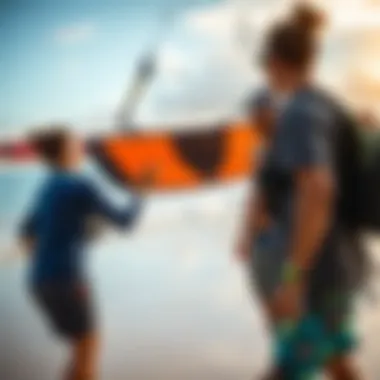
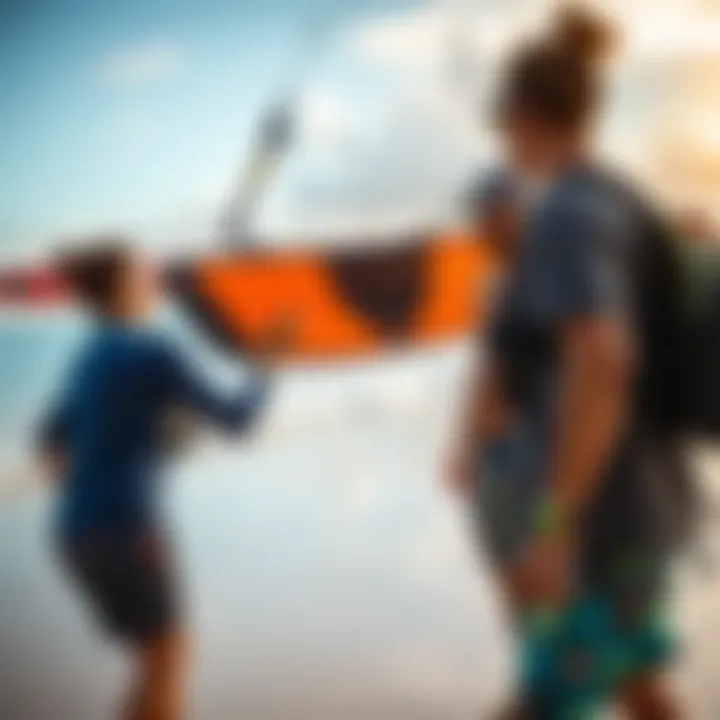
- Advantages of Snorkeling and Diving:
- Biodiversity Exposure: Ah, the thrill of seeing marine life flourishing in their natural habitat can be an awe-inspiring experience.
- Relaxation: Engaging in these activities can offer a more peaceful engagement with nature, contrasting with the thrill of kitesurfing.
- Skill Building: Both snorkeling and diving afford great opportunities to develop underwater skills that can translate to better buoyancy and comfort while kitesurfing.
With such an array of water sports to engage in, kitesurfers visiting Punta Cana can enhance their overall experience. Rather than solely focusing on kitesurfing, they have the chance to explore diverse activities that foster appreciation for both the ocean and the community surrounding it.
Travel Logistics for Kitesurfers
Travel logistics play a crucial role in the overall experience of kitesurfing in Punta Cana. For kiteboarders, understanding how to get to the prime spots, where to stay, and when to book can make all the difference in optimizing one’s kitesurfing excursion. Failing to consider these elements can lead to missed opportunities on the water, wasted time, and added stress.
This section will navigate through essential transportation options and accommodation recommendations tailored specifically to the needs of kitesurfers. Keeping these factors in mind ensures a smoother trip, enabling kiteboarders to focus more on riding the wind and waves.
Transport and Accessibility
Getting to Punta Cana is relatively straightforward, given that the area is serviced by the Punta Cana International Airport. This airport allows kiteboarders from all over the world to access the region with ease. Upon arrival, travelers have several options for transport:
- Airport Shuttles: Pre-arranging an airport shuttle service is a popular choice. Many kitesurfing schools and hotels offer shuttle services, making the transition from the airport to your accommodation seamless.
- Car Rentals: For those looking to explore more than just the immediate beaches, renting a car can be quite a smart move. Several agencies operate near the airport and in town, offering flexibility in travel plans.
- Public Transport: Buses and local taxis are readily available and can be a cost-effective option. However, while this option can be economical, it's essential to have a grasp on the local routes and schedules.
- Biking or Walking: Once local, if your accommodation is near the beach or kitesurfing sites, renting a bike could provide easy access to several kitesurfing hotspots while enjoying the scenic surroundings.
Travelers should also be aware of the local road conditions, as they might differ from what they are used to. In some places, roads may be unpaved or crowded, which could impact travel time.
Accommodation Recommendations
Finding the right accommodation is vital, particularly for kitesurfers who need to be close to the action without compromising comfort. Here are some types of accommodations that cater well to enthusiasts:
- Kitesurfing Resorts: Look for resorts like the Melia Punta Cana, which offer direct access to world-class kitesurfing spots along with on-site rental facilities. Having direct beach access means less time traveling and more time kitesurfing.
- Boutique Hotels: Smaller, boutique hotels in the area can provide a cozy atmosphere while being close to kiteboarding schools. Searching for accommodations that cater specifically to water sports enthusiasts usually proves beneficial, as they’re more attuned to the needs of kitesurfers.
- Shared Apartments or Vacation Homes: Platforms like Airbnb can be useful for finding spaces that can house multiple kiteboarders who want to share costs while enjoying communal living. Look for places with easy access to the beach and amenities like outdoor showers for rinsing gear.
- Camping Options: For the more adventurous, campgrounds are available in Punta Cana where kiteboarders can pitch tents or rent cabins. This option brings thrill and a unique experience close to the sea.
Regardless of the type of accommodation chosen, it is advisable to book early, especially during peak kitesurfing seasons. Checking reviews on platforms like TripAdvisor and Reddit can give insights into the experiences of other kitesurfers, ensuring you make an informed decision.
By proactively addressing travel logistics, kiteboarders can significantly enhance their overall time spent in Punta Cana, diving straight into their kitesurfing adventure with minimal hassle.
Cultural Experience in Punta Cana
Diving into kitesurfing at Punta Cana isn't solely about the thrill of catching wind and waves; it's also a gateway to experiencing the rich culture that permeates every corner of this Caribbean jewel. The area's vibrant local scene is as crucial to enhancing your kitesurfing experience as the clear waters and steady breezes. Understanding local customs, traditions, and flavors can greatly enrich one's journey, transforming it into a multi-dimensional adventure.
Local Cuisine and Dining Options
When in Punta Cana, your taste buds are in for an incredible treat. The local cuisine reflects a mosaic of influences, particularly from indigenous Taino, African, and Spanish tones.
Don't miss out on trying sancocho, a hearty soup that showcases various meats and root vegetables. It's a comforting dish that warms the soul after a day on the water. Another local delight is mangu, mashed plantains often served with eggs and salami, perfect for fueling up before kiting.
For casual dining, you might wander into a beachside taberna, where the ambiance is laid-back and the options plentiful. From fresh ceviche to grilled lobster, the seafood here shines because, well, it doesn't get much fresher than a few hours out of the ocean.
Some popular dining options include:
- Bento: Known for its fusion of Japanese and Caribbean flavors, offering a unique twist on traditional dishes.
- La Yola: Sitting right on the water, this restaurant specializes in fresh catch, making it a scenic spot to watch the sunset.
- Café del Mar: Perfect for sipping on a craft cocktail while getting a taste of the local vibe.
You might also find local street vendors serving up empanadas or pique, a spicy sauce that often accompanies various dishes. Enjoying these foods while mingling with locals offers insights into their daily lives, bringing a sense of authenticity to the overall kitesurfing adventure.
Exploring Punta Cana’s Attractions
Punta Cana is not just about the waves; the surrounding attractions provide a wealth of experiences to explore. After spending time kitesurfing, taking a break to discover the local sights can enrich your visit in many ways.
Head to the Indigenous Eyes Ecological Park, a hidden gem that features a series of lagoons and paths winding through lush vegetation. A refreshing dip after a day's surfing can do wonders for your muscles and spirit.
Another must-visit is the Bávaro Beach, often recognized as one of the most beautiful beaches in the world. Strolling along its coastline, you'll encounter local artisans selling handcrafted goods, which provide the perfect souvenir.
For the more adventurous, consider a trip to Saona Island, an idyllic spot that gives you a taste of the Caribbean’s best with its powdery white sand and crystal-clear waters. It’s a great escape for relaxation or just to soak in the natural beauty away from the hustle of kitesurfing.
"Traveling — it leaves you speechless, then turns you into a storyteller." - Ibn Battuta
Whether it’s indulging your palate or adventuring into nature, embracing these cultural aspects will set the tone for not just a physical journey but also a personal one, allowing you to reflect on the connections made along the way. Finding balance between kitesurfing and cultural immersion often yields more rewarding memories.
Sustainability in Kitesurfing
In today’s world, sustainability is not just a buzzword; it’s an urgent call to action. The recreational sport of kitesurfing, particularly in thriving destinations like Punta Cana, brings with it a growing responsibility towards the environment. As kiteboarders take to the water, they must also consider their impact on local ecosystems and communities. The focus on sustainable practices can enrich the experience, ensuring that future generations can enjoy these beautiful waters as much as we do now.
Environmental Impact of Kitesurfing
Kitesurfing, while exhilarating, can pose certain threats to the local environment. The act of flying kites and riding boards can disrupt marine life, particularly in areas where ecosystems are delicate and fragile. Coastal areas may see shifts due to the inevitable wear and tear caused by boarders. Common issues include:
- Soil Erosion: Launching and landing kites can lead to erosion of sandy shores and dune systems that serve as vital habitats.
- Wildlife Disruption: The noise and presence of kitesurfers can interfere with animal behavior, from nesting sea turtles to migratory birds.
- Pollution: Often forgotten, waste generated from kitesurfing activities—think of plastic water bottles or lost equipment—can accumulate, endangering marine life.
To monitor these challenges, local communities and environmental organizations often work together, conducting research and promoting awareness among kitesurfers. By engaging with these efforts, kiteboarders can become stewards of the very environment that provides their thrill.
Promoting Sustainable Practices
Promoting sustainability in kitesurfing doesn’t only benefit the environment; it also enhances the quality of experience for practitioners. Here are several significant ways that kitesurfers can adopt more sustainable practices:
- Respect Sensitive Areas: Choose kitesurfing spots wisely, avoiding areas that are known to be breeding grounds for wildlife or important habitats.
- Use Eco-Friendly Gear: Look for equipment that is made from sustainable materials. Certain brands focus on environmentally friendly production practices, which can significantly lessen ecological footprints.
- Participate in Clean-Ups: Join local initiatives aimed at cleaning beaches and aquatic environments. Many kitesurfing communities organize regular clean-up days, which not only improve conditions but also foster camaraderie among enthusiasts.
- Educate Peers: Share knowledge about sustainability with fellow kitesurfers. Discuss the importance of environmental conservation and promote respectful behaviors in the water.
- Support Local Conservation Groups: Consider donating a portion of adventure or rental income to local organizations that prioritize environmental protection.
"Kitesurfing is not just about the thrill; it's also about taking care of the playground that gives us so much joy."
By embracing these practices, kitesurfers in Punta Cana—and beyond—can actively contribute to safeguarding the environment. As they continue to ride the waves, they can do so with the promise that both the sport and the surrounding nature will thrive harmoniously for years to come.
Epilogue: Embracing the Kitesurfing Lifestyle
Kitesurfing isn't just a sport; it's a way of life for many enthusiasts. This conclusion serves as a reflective pause to consider what kitesurfing in Punta Cana truly offers—not just in terms of adrenaline, but also in personal development and community connection. Through the highs of catching a perfect wave and the lows of wipeouts, kitesurfing provides a spectrum of experiences that shape one's character and outlook on life.
Reflecting on Personal Growth
When you learn how to kitesurf, it's almost like embarking on a rite of passage. Each session challenges you, tests your limits, and gradually builds both skill and confidence. It’s not just about standing on a board; it's about overcoming obstacles, navigating storms, and finding your balance—figuratively and literally.
From the very first windswept gust that takes you by surprise to the exhilarating feeling of mastering jumps, every moment counts. Learning this skill fosters resilience. You may face tumbles and frustrations along the way, but with each fall, you get up stronger, more knowledgeable. These lessons extend well beyond the water, influencing how you handle challenges in everyday life. The drive to improve, to keep trying despite adversity, becomes ingrained—a personal mantra for many who’ve taken to the kite.
The Future of Kitesurfing in Punta Cana
Punta Cana, well-known for its idyllic beaches and vibrant culture, holds great promise for the future of kitesurfing. As the sport grows in popularity, advancements in equipment and technique continue to evolve. It’s worth noting that local initiatives to promote sustainable practices and environmental stewardship only add to its appeal.
As technology develops, we can expect to see even more collaborative events and competitions, fostering a tightly-knit community of kitesurfers from around the globe. New kitesurfing schools are likely to spring up, catering to all skill levels, ensuring that Punta Cana remains a premier destination for both novices and seasoned experts. These developments not only benefit enthusiasts but also enhance the economic landscape of the region, attracting tourism and boosting local businesses.
In summary, embracing the kitesurfing lifestyle is more than just the thrill of the ride. It embodies a journey of personal growth, community, and a forward-thinking approach that ensures the sport thrives for generations to come.


